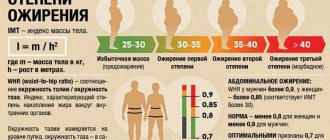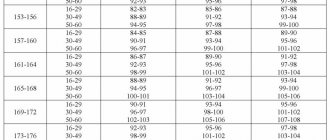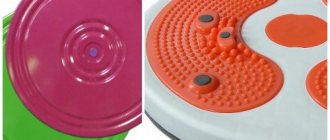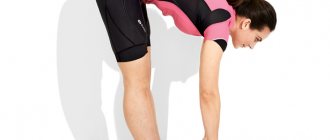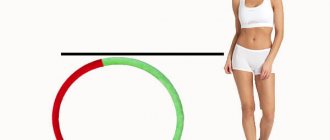Over the past decades, the average waist has been seriously spreading.
The most successful waist-to-hip ratio for women is considered to be 0.7 or less. However, in the modern world this figure is closer to 0.8. It's important to understand that a larger waist doubles your risk of premature death from all causes. Every extra 5 cm around the waist increases the risk of premature death by 13% in women and 17% in men. Dr. Andrey Beloveshkin about indicators that can be measured independently.
We only need a measuring tape and a telephone (calculator). Yes, I remind you again that it is not excess weight in itself that is harmful, but internal (abdominal, visceral) fat. At risk are some people with a completely normal overall height-to-weight ratio, but with a large waist circumference. Twin studies have shown that in 22-50% of cases, the waist-to-hip ratio can be explained by genetic factors.
Among other factors, the first places are occupied by nutrition and lifestyle.
Waist circumference (centimeters).
The normal waist circumference for women is 80 centimeters (this is the upper limit, which should not be exceeded), women with a smaller circumference can only rejoice, because they have a normal weight, when the circumference ranges from 80 to 88 centimeters - this is a slight increase in weight, over 88 - obesity.
In general, women with thin waists are more attractive to the opposite sex. An ideally proportioned woman should have a waist-to-hip ratio of approximately 0.7 (more precisely, between 0.60 and 0.72).
For men, normal parameters are up to 94 centimeters, from 94 to 102 – weight gain, and more than 102 – a threat, that is, obesity. These people have an increased risk of dying from heart disease and cancer.
Statistics are given: in men with a waist circumference of at least 100 cm, the mortality rate is 50% higher than in those whose waist circumference was less than 89 cm. The researchers gave the example of a man with a height of 178 cm. If such a person has a waist circumference of 107 cm, his life may be reduced by 1 year and 7 months. Even with normal weight, a large waist size affects life expectancy.
Factors that may influence waist circumference
Several factors influence a person's waist circumference. These include:
Genetics
A 2022 meta-analysis found that genes play a role in body fat distribution, particularly waist-to-hip ratio. Consequently, some people are more likely to have fat around their waist than on their hips. Genetics may explain why some families are more likely to be apple-shaped while others are more likely to be pear-shaped.
While people are unable to change their basic body shape, it is possible to reduce the amount of fat around the waist.
Ethnicity and gender
Visceral abdominal fat is less common among those living in Mediterranean countries. In contrast, Native Americans, Pima Indians, Hispanics, and those living in India and South Asia are more likely to have abdominal obesity. Black men and white women generally have less visceral abdominal fat than white men and black women.
Activity level
People who lead a sedentary lifestyle have more abdominal fat than those who are more active during the day. Watching TV and playing video games have positive associations with increased abdominal fat and obesity among both men and women.
Food
Certain types of foods may increase the risk of obesity and belly fat, including:
- sweet foods and drinks
- processed products
- trans fats
- alcohol
Eating a lot of calories, regardless of the type of food, can lead to weight gain. For those who have an apple-shaped figure, this extra weight will accumulate on the stomach. A diet low in protein and fiber can also affect a person's waistline.
Other factors also play a role in increased abdominal fat, including:
- stress
- hormonal changes such as menopause
- lack of sleep
- imbalance in gut bacteria
Waist-hip circumference index. WHR (waist-hip ratio).
Waist/hip ratio. Waist circumference is measured at the level of the navel. Pelvic circumference is measured at its widest point. Normally, this index is less than 0.85 for women and less than 1.0 for men. If a person has abdominal-visceral obesity, he or she has a WC/TB ratio of more than 0.85 in women and more than 1.0 in men (Stern et al., 1995). Hip circumference is measured below the greater femoral tuberosities.
According to the World Health Organization (WHO) protocol, waist circumference should be measured midway between the lower edge of the lower rib and the top of the iliac crest (the upper pelvic bone, seen from the side). A measuring tape is used for this. When tightened, it should create a pressure equivalent to 100 grams. Hip circumference should be measured around the widest part of the buttocks, using the same tape, parallel to the floor.
The US National Institutes of Health and the National Nutrition Examination Program use results obtained by measuring at the top of the iliac crest—essentially where we typically have the waistband of standard pants.
Often, non-professionals measure the waist at the level of the navel, but studies have shown that this method can often result in an understatement of its actual circumference.
When measuring both circumferences, a person should place his feet side by side, arms apart, body weight evenly distributed, and there should be no excess clothing. Breathing should be normal, calm, and measurements should be taken at the end of exhalation. Each measurement is repeated twice, and if there is a centimeter difference between them, then the average results are taken.
In practice, in order not to delve into all these subtleties, the waist with a slender figure is most correctly measured simply in the area of its smallest circumference, as a rule, slightly above the navel. In cases where the waist is convex rather than concave, for example, as happens during pregnancy or when you are overweight, the location of the smallest circumference is often more difficult to determine. In such cases, to determine the degree of obesity, a measurement is taken a couple of centimeters above the navel. Hip circumference can be measured simply visually at the widest part of the buttocks.
Some aspects of the waist and health
Casual is a women's magazine about fashion, style and beauty.
The great Leonardo da Vinci was one of the first to study and define the ideal parameters of the human body. The anatomical proportions he presented are still studied in art schools all over the world. From Leonardo da Vinci’s theory of ideal proportions it follows that the volumes of the chest, waist and hips, taken separately, do not solve anything, it’s all about their ratio.
In modern society, changes in the parameters of the human body (anthropometric data) are revised every 15 years, because during this period, as a result of the acceleration process, changes in the size, proportions and shapes of the figure
person.
The well-known 90 – 60 – 90, of course, are not the standard of ideal female
proportions for everyone. Body proportions generally cannot be the same for all women, since there are different body types given to us genetically.
Main body types
The main body types include asthenic (thin-boned), normosthenic (normal-boned) and hypersthenic (broad-boned).
- Women with an asthenic (thin-boned) body type have thin bones, long limbs, a thin neck, and muscles are relatively poorly developed. Representatives of this type are usually light in weight, they are energetic and active. Eating plenty of food for quite a long time does not lead them to gain weight, since they spend energy faster than they accumulate. If a woman of this type does not have a very thin waist and normal, not narrow hips, everything seems miniature because of the thin bone.
- The physique of normosthenic women (normal bone type) is distinguished by the proportionality of the main body dimensions, the correct ratio. The most beautiful female figures
are found with this body type.
- In representatives of a hypersthenic (big-boned) physique, the transverse dimensions of the body predominate. Their bones are thick and heavy, their shoulders, chest and hips are wide, and their legs are sometimes somewhat short. Women of this type need to remember that they tend to be overweight.
You can determine your approximate body type by measuring the circumference of the wrist of your working hand. For normosthenics it is 16-18.5 cm, for asthenics it is 16 cm, and for hypersthenics it is 18.5 cm.
Quite often there are mixed body types with a predominance of the parameters of the above types.
If we talk about gradations of womanhood
height, then they are as follows: low height - 150 cm and below, below average height - 151-156 cm, average height - 157-167 cm, high - 168-175 cm, very tall - 176 cm and above.
True, in recent years this gradation needs to be changed taking into account the acceleration of modern youth, so normal height can be considered for normal and large-boned people from 166 to 170 cm, and for thin-boned people from 168 to 172 cm.
Correct legs
There are certain proportions between height and leg length. Legs can be considered short if their length is less than half the height. A figure can be considered proportional
when the length of the legs is more than half the height. For those with large bones, it is desirable to be 2-4 cm, for those with normal bones, 4-6 cm, for those with thin bones, 6-9 cm. For example, if with a normal bone type with a height of 168 cm, the leg length is 90 cm, then this is ideal.
The length of the legs should be measured from the protrusion of the femur to the floor. In cases where the legs are somewhat shorter than the accepted norm, shoes with heels will help change this ratio, since visually they eliminate the existing imbalance.
The diameter of the leg at the calf, depending on the body type, ranges from 36 to 40 centimeters, at the ankle from 16 to 20 cm. Experts even tried to compile a table of the ideal leg shape depending on the body type. Here are the approximate parameters: with a height of 156 and a weight of 50 - 55 kg - leg circumference at the hip is from 48 to 54 cm, in the calf 31-32 cm, in the ankle 18-20 cm; with a height of 160 and a weight of 55-58 kg - leg circumference at the thigh - from 50 to 56 cm, in the calf 32 - 35 cm, in the ankle 19 - 22 cm; with a height of 167 and a weight of 56-65 kg, the leg circumference at the hip is from 52 to 58 cm, at the calf 33-36 cm, at the ankle 22-23 cm.
And above all, ideal legs should have three gaps between them. To do this, you need to stand in front of a large mirror and put your feet in the position - heels together, toes apart. You should see the first gap under the knees, the second at the ankles, and the third at the top closer to the hips. In other places the legs should converge.
Correct weight
Body weight depends on the body type, height and, very importantly, the age of the person. One option for calculating weight is the Quetelet index. According to this index, for women with a thin-boned body type, it is enough to have 325 g for every centimeter of height, for normal-boned women - 350 and for large-boned ones - 375 g. Then the index is multiplied by height, and the weight corresponding to your parameters is obtained. It must be emphasized that the ideal weight of women, especially those whose height is below 160 cm, should be 10-15% less than normal. For short women, at least under 20 years of age, it is advisable to weigh 3-5 kg less than normal, i.e. calculated using the Quetelet index.
As mentioned above, body weight also depends on age. The table shows the weight-to-height ratio (weight in g divided by height in cm) for women aged 15 to 40 years.
| Age (years) | Body types | ||
| thin-boned | Normoskeletal | Broad-boned | |
| 15-18 19-25 26-39 | 315 325 335 | 325 345 360 | 355 370 380 |
To determine your normal weight, you need to multiply your height in cm by the weight-height coefficient corresponding to your age and body type.
Excess weight can be tracked by measuring the fat fold on the abdominal wall, above the navel, 3 cm from the midline. Its thickness should normally be from 1 to 2 cm.
Hips, waist and chest
Knowing your body circumferences—chest, waist, and hips—also helps determine your body type. This indicator is called “whites”.
Normal whites indicators for young women (18 - 28 years old) of a normosthenic body type can be considered if the chest circumference is equal to half the height plus 2-5 cm, for the bust - chest circumference plus 8-10 cm, for the waist - standing height, minus 100, the hips should be
approximately 25-30 cm larger than the waist circumference. For thin-boned women, it can be considered normal if their chest circumference is in the range of 84-86 cm, and their bust is plus 4-6 cm to the indicated figures.
Their waist is usually thin and ranges from 60-64 cm, and their hip circumference is approximately 25-30 cm larger. In women with a broad-boned body type, the chest circumference exceeds half the height by 8-10 cm, chest - by another 8-10 cm. The waist circumference with a height of 166-168 cm is within 70-76 cm, and the hip circumference is larger by the same 25-30 cm.
Devendra Singh, a professor of psychology at the University of Texas, came to approximately the same conclusion in the early nineties. Only he calculated the proportion between the hips and waist as a percentage. According to his theory, the ideal proportions are those in which the waist volume is from 60 to 70% of the hip volume.
To do this, you need to divide the waist volume by the hip volume, the resulting coefficient should be from 0.6 to 0.7. By the way, the ideal beauties according to this ratio are the Venus de Milo - 70% and the Nude by Rubens, the same 70%. But among real women, the waist-to-hip ratio is ideal: Marilyn Monroe 0.61 (56/91.5), Brigitte Bardot 0.66 (58.5/89), Demi Moore 0.72 (66/91), Claudia Schiffer 0.67 (62/92), Cindy Crawford 0.69 (58/84), Gisele Bundchen 0.70 (61/86), Kylie Minogue 0.70 (63/89).
Doctors believe that the ratio of waist circumference to hip circumference should not exceed the endocrine balance coefficient, which is 0.85. If your waist does not exceed 85% of your hips, then your figure
in perfect order both from an aesthetic and medical point of view.
Time moves forward, new criteria for assessing the beauty of a female figure appear. The latest analysis of the results of an anthropometric examination of women, carried out in our country at the beginning of 2000, showed significant changes in body proportions. Young women have longer arms and legs, a higher waistline, wider shoulders with the same body size, and improved posture. So we can conclude that the young and middle generations of women have become taller and slimmer than the previous generation. Well, if your parameters do not match the ideal ones, don’t be upset! Still, the most important thing in a woman is her individuality and, of course, her well-groomed appearance.
Character.
Women with a wider waist are characterized by “masculine behavior.” Visceral obesity is associated with an increase in testosterone. And for men it’s the opposite. According to Cashdan, in countries where women occupy a subordinate position in economic terms (Japan, Portugal, Greece), thin waists are more common among local residents. In countries with pronounced gender equality (Denmark, Great Britain) the situation is exactly the opposite.
A woman’s waist is more than 80 centimeters: which doctor should she consult?
When you don’t like your figure and your waist is more than 80 centimeters, then this is a reason to go to a specialist doctor - an endocrinologist. Thanks to diagnosis, it is possible to prevent the development of all kinds of serious diseases in the early stages.
To make sure that you are healthy, you can immediately undergo a test such as bioimpedancemetry , thanks to which you can find out in detail the percentage of fatty tissue in the abdomen. The standard ratio can vary between 22–31% of total body weight.
Reproductive health.
Women with thin waists enjoy better health. In addition, they are less likely to suffer from infertility and chronic diseases of the reproductive system. Therefore, a low WHR indicates good health and fertility. A recent study found that in vitro fertilization was more successful in women with a WHR between 0.70 and 0.79 than in women with a WHR greater than 0.80. Women who do not have a waist are more likely to have problems conceiving.
Studies have shown that if the female body secretes too little estrogen, then the notorious coefficient (0.7), as a rule, exceeds the norm. And if you compare a woman whose coefficient is 0.9 with a woman whose coefficient is 0.8, then the first one is one third less likely to get pregnant. By the way, in those areas of the planet where ideas about beauty differ from the Euro-American standard, the ratio of waist to hip sizes also approaches the above-mentioned coefficient. Thus, in a number of African countries, men prefer plump women with wide hips, respectively, with sizes of 100 and 135 centimeters. And now - 100: 135 = 0.74. Be patient! The main thing is that the waist is noticeably narrower than the hips.
How to take measurements without a centimeter
You can simply measure your hip circumference using thread. For this you will need a ruler. The thread is wrapped around the hips and the excess is cut off. To find out the length of the thread, just attach it to a ruler.
The products selected as meters should not be of any value, because they will need to be shortened or marked in the process. Most likely, after the procedure, the improvised centimeter will have to be thrown away. If you don’t have a ruler at hand, you can pay attention to objects with straight edges.
Look for something flexible for taking measurements.
Find an object with exactly known length
Apply a scale with centimeter marks to the selected material for measurements
Measure your hips
For example, an A4 sheet - its length is 29.7 cm, width - about 21 cm. Banknotes in denominations of 500 and 100 rubles. standard sizes - length - 15 cm, width - 6.5 cm. A scale must be applied to the material selected as a meter. Experts recommend marking every centimeter - this will allow you to take measurements as accurately as possible.
Higher mental abilities.
Research has also shown that women with large differences between their waist and hip measurements have especially sharp minds. Accordingly, the greater the difference between a woman’s hips and waist, the better her cognitive performance.
In their study, scientists examined the abilities of 16 thousand girls and adult women and came to the conclusion that more curvaceous representatives of the fair sex demonstrate better results on mental tests. The reason lies in the fatty acids that accumulate in the thighs. It is in this part of the body that the highest concentration of Omega-3 acids is observed, which improve the mental abilities of a woman during pregnancy and her unborn baby.
To sew which clothes will you need to measure your hip circumference?
There are several ways to measure hip volume. Taking measurements is necessary if a person plans to sew clothes on his own or to order in a studio. In the process, they take into account the protrusion of the abdomen and focus on the protruding points of the buttocks. In order not to make mistakes in the calculations, it is necessary to correctly position the tailoring tape.
Hip circumference is required when sewing skirts, trousers and coats
Measuring the hip circumference is necessary for sewing various waist products:
- coats (balmakaans, peacoats, dusters, invernesses, capes, covercoats, copars, crombies, down jackets, raglans);
- raincoats (mackintoshes, gubertuses, raincoats, trench coats, capes);
- trousers (cargo, flared, culottes, leggings, leggings, palazzo, leggings, skinny, slacks, jeans, capris, joggers);
- skirts (straight, slanting, wraparound, tapered, conical).
Measuring your hip circumference may be necessary when sewing jackets, cardigans and other outerwear.
Cardiovascular health.
Waist size quite reliably indicates an increased risk of hypertension, diabetes and high cholesterol. Studies have confirmed that health risks begin to increase if a woman's waist reaches 80 centimeters; at 89 centimeters it increases significantly. For men, the risk increases from 94 centimeters. Then we will talk about adjusting for height, because these are relative figures, and they are not suitable for people who are too tall or too short, for children, and also for representatives of some ethnic groups. For example, among the Japanese, the risk increases sharply if the waist size in men reaches 85 centimeters, and in women - 90 centimeters. The risk of stroke is increased sevenfold.
Tips for reducing your waist size
Although it is not possible to reduce fat in certain areas, any weight loss for people with excess fat can help. Losing as little as 5-10% of body weight can reduce health risks in overweight or obese people.
Some tips for reducing weight and waist size:
- Perform 150 minutes of moderate activity exercise (or 75 minutes of vigorous activity) weekly
- strength training at least 2 days a week
- Eat a balanced diet with fruits and vegetables, whole grains, lean proteins and healthy fats
- avoid sugary and processed foods and foods made with refined flour
- limit or avoid alcohol consumption
- control your portions
- drink enough water
- sleep 7-9 hours at night
- use stress management techniques, including meditation and yoga
People with type 2 diabetes, heart disease, or other health problems should see a doctor or dietitian who can advise appropriate diet and exercise to reduce belly fat.
Cancer.
A study published in the Archives of Internal Medicine found that it also increases the chances of dying from cancer, respiratory failure and other causes. After all, a large waist circumference indicates an excessive amount of fat around the abdominal organs. And this is usually associated with inflammation, high cholesterol, risk of diabetes and other problems.
By measuring your waist using a tape measure, you can determine whether you are at risk. The norm is 90 cm for men and 75 cm for women. Regarding overweight people, the conclusion of American scientists is this: extra 30 cm in men and 32 cm in women doubles the risk of death. As for women with normal weight, the research results are completely stunning. Every extra 10 cm in the waist increases the likelihood of acquiring a fatal disease by about 25%.
Literature
- Cameron AJ et al. The influence of hip circumference on the relationship between abdominal obesity and mortality //International journal of epidemiology. – 2012. – T. 41. – No. 2. – pp. 484-494.
- Mørkedal B., Romundstad PR, Vatten LJ Informativeness of indicators of blood pressure, obesity and serum lipids in relation to ischemic heart disease mortality: the HUNT-II study //European journal of epidemiology. – 2011. – T. 26. – No. 6. – pp. 457-461.
- Romaguera D. et al. Food composition of the diet in relation to changes in waist circumference adjusted for body mass index //PloS one. – 2011. – T. 6. – No. 8. – P. e23384.
- Singh D. Female mate value at a glance: Relationship of waist-to-hip ratio to health, fecundity and attractiveness //Neuroendocrinology letters. – 2002. – T. 23. – No. Suppl 4. – pp. 81-91.
- Son YJ et al. Association of waist-height ratio with diabetes risk: a 4-year longitudinal retrospective study //Endocrinology and Metabolism. – 2016. – T. 31. – No. 1. – pp. 127-133.
- Zhang C. et al. Abdominal obesity and the risk of all-cause, cardiovascular, and cancer mortality //Circulation. – 2008. – T. 117. – No. 13. – pp. 1658-1667.
Cancer in hormonal-dependent organs (breast and prostate).
The accumulation of fat deposits around the waist over a lifetime is directly linked to an increased risk of breast cancer after menopause, British researchers have found. Statistical analysis showed that the rate of increase in skirt size between 25 and 55 years of age is a clear indicator of the risk of developing the disease later in life: increasing waist circumference by one size every ten years increases this probability by 33 percent, and by two sizes increases this probability by 77 percent. .
Research shows that women whose WHR remains in the 0.7 range have optimal estrogen levels and are less susceptible to diabetes, cardiovascular disease and genital cancer. Men with a WHR of approximately 0.9 have good potency. These men have a low risk of developing prostate cancer.
Excess fat around the waist: harmful to health
Excess fat tissue around the waist, around important internal organs, is abdominal fat. If the fat tissue ratio is normal, then this will not cause any complications, but excess fat is already toxic to all body systems.
It’s also bad when there is a lack of fat mass, because then little estrogen (sex hormones) is synthesized. But obesity poses even more problems. There is a disruption in the metabolic function of adipose tissue and then various inflammatory molecules appear, destroying the normal metabolic process in all systems of the body.
